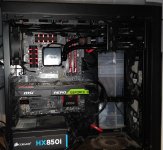I am wondering if infact it is a 450D. The 750D can mount a 140mm rear exhaust, and in my case its just a 120, with no room to expand to a 140.
In that case, I would imagine it is the 450D (and looking at that pic you just added, it does look more 450D than the rest). The only reason why I was so sure it's not the 650D, is because I'm in the middle of silencing my own one. So quite familiar with it (and what you can and can't do with it).
I am just playing around with fans and layout to understand a bit more about it in all honesty. When I load up cs:go the blower on the 1080Ti takes off and I can hear nothing over it (thank god for good quality headphones!)
Are you sure it's not just what that particular GPU does?
Looking at your setup there, I would add a few of my thoughts on the rig you have there.
I would say that it is impossible to get better cooling via air for your GPU without sacrifing something elsewhere. Noise, Dust (Positive/Negative Pressure), Higher CPU temps, Higher GPU temps, Fan Speeds.
If you add more fans as Intake (at the bottom I'm thinking, near the other Intake fans at the front of the case), then you could get a bit more Positive Pressure that helps with a bit of dust, but at the same time, that fan could end up disrupting the air coming in from the front of the case and heading towards the GPU and rear of the case. Depending on how severe this disruption is, you could end up inadvertently reducing cool air that reaches the bottom of the GPU in the PCI slot area. The only real way to know is testing with the fans you get unfortunately. As reference, in my 650D, I had fans at the front bringing in cool air and a rear fan Exhausting. My AIO at the top was tested in both Exhaust and Intake. Because of the fans I had, when set to Intake, the fans basically overpowered any airflow from the front to the rear, and caused temperatures to increase on the CPU and GPU, despite common sense suggesting otherwise. As well as causing a Hot Spot to develop in the corner of the case (Above the rear Exhaust fan, because it was unable to remove the hot air quickly enough). So in the end I left the Rad fans at the top as Exhaust, rather than as Intake (at the cost of better Positive Pressure, I ran into minor amounts of Negative Pressure instead). Depending on what fans you have, you may find that the Rad at the top being in Exhaust may yield better temps overall.
If the GPU is making that much noise, then if you want more silence, that'll be your main target to reduce noise generated first. But I'm not familiar with Nvidia cards, so I don't know how well or even if it is possible to Undervolt and maybe Underclock that GPU to reduce temps so the fans don't need to work as hard keeping it cool. Also, if you can control the fan on that GPU, work in some tests to get it working closer to its thermal limit (temperature the GPU throttles at) if that is possible. That should allow you to cut down on sound generated by it enough that any changes to the rest of your system should be more noticable. For reference: My RX580 was undervolted and the fan curve modified to cool the GPU just enough that it only reaches 83-85C during the recent hotter weather; The RX580 Thermal Limit before throttling is 90C. So by doing this I was able to let it run a bit hotter, but without the fan spinning up to crazy sound levels to keep it as cool. After doing this, I was able to slowly modify and silence the rest of the system since the noise they produced was no longer being drowned out by the GPU fan. (I was after silence over more performance)
But any info is really best tested out on your own rig to find the best results for your setup really. So do play around with the config of the fans more. As above, I found some common tips didn't work in my case (partly because of a bad case design). And normally ill advised suggestions worked better than preferred suggestions. So once you get your fans, don't automatically assume one setup is going to be best for your rig.





